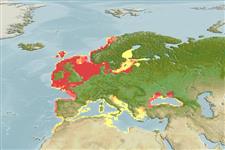>
Clupeiformes (Herrings) >
Clupeidae (Herrings, shads, sardines, menhadens)
Etymology: Sprattus: Old German, sprotte (1611) = a small fish, Clupea sp. (Ref. 45335).
More on author: Linnaeus.
Environment: milieu / climate zone / depth range / distribution range
Sinh thái học
Biển; Thuộc về nước lợ; Ở đại duơng, biển (Ref. 51243); Mức độ sâu 10 - 150 m (Ref. 6302). Temperate; 69°N - 30°N, 11°W - 42°E
Northeast Atlantic: North Sea and adjacent waters as far north as the Lofoten Area and the west of the British Isles, and Baltic Sea south to Morocco; also in northern Mediterranean (Gulf of Lion and the Adriatic Sea) and Black Sea.
Length at first maturity / Bộ gần gũi / Khối lượng (Trọng lượng) / Age
Maturity: Lm 10.1, range 8 - 12 cm
Max length : 16.0 cm SL con đực/không giới tính; (Ref. 188); common length : 12.0 cm SL con đực/không giới tính; (Ref. 188); Tuổi cực đại được báo cáo: 6 các năm (Ref. 3561)
Các tia vây lưng cứng (tổng cộng): 0; Các vây lưng mềm (tổng cộng): 13-21; Tia cứng vây hậu môn 0; Tia mềm vây hậu môn: 12 - 23. Lower jaw slightly projecting, gill cover without any bony radiating striae, teeth rarely present on vomer; belly with a strong keel of scutes; last two anal fin rays not enlarged. No dark spots on flanks. Pterotic bulla absent.
Usually inshore schooling, sometimes entering estuaries (especially the juveniles) and tolerating salinities as low as 4 ppt. Shows strong migrations between winter feeding and summer spawning grounds. Moves to the surface at night. Feeds on planktonic crustaceans (Ref. 9900). Spawns at depths of 10-20 m producing 6,000-14,000 pelagic eggs (Ref. 35388). Some spawn almost throughout the year, mainly in spring and summer, near the coast or up to 100 km out to sea, the young drifting inshore. Sold as 'brislings' to canneries. Sprat are used in the production of fish meal and as mink food, less for human consumption (Ref. 9900). Utilized fresh, smoked, canned and frozen; can be pan-fried and broiled (Ref. 9988).
Some spawn almost year round but mainly in spring and summer, near to the coast or up to 100 km out to sea, the young drifting inshore. Individual period of spawning takes about two months (Ref. 92054).
Whitehead, P.J.P., 1985. FAO Species Catalogue. Vol. 7. Clupeoid fishes of the world (suborder Clupeoidei). An annotated and illustrated catalogue of the herrings, sardines, pilchards, sprats, shads, anchovies and wolf-herrings. FAO Fish. Synop. 125(7/1):1-303. Rome: FAO. (Ref. 188)
IUCN Red List Status (Ref. 130435)
Threat to humans
Reports of ciguatera poisoning (Ref. 30911)
Human uses
Các nghề cá: tính thương mại cao; mồi: usually
Các công cụ
Special reports
Download XML
Các nguồn internet
Estimates based on models
Preferred temperature (Ref.
123201): 4.3 - 15.3, mean 9.5 °C (based on 530 cells).
Phylogenetic diversity index (Ref.
82804): PD
50 = 0.5312 [Uniqueness, from 0.5 = low to 2.0 = high].
Bayesian length-weight: a=0.00575 (0.00491 - 0.00675), b=3.09 (3.04 - 3.14), in cm total length, based on LWR estimates for this species (Ref.
93245).
Mức dinh dưỡng (Ref.
69278): 3.0 ±0.07 se; based on food items.
Generation time: 2.2 (1.7 - 2.6) years. Estimated as median ln(3)/K based on 23
growth studies.
Thích nghi nhanh (Ref.
120179): Trung bình, thời gian nhân đôi của chủng quần tối thiểu là 1.4 - 4.4 năm (rm=1.7; K=0.14-0.77; tm=1-2; tmax=6; Fec=2,000 (batch fec)).
Prior r = 0.49, 95% CL = 0.32 - 0.74, Based on 13 stock assessments.
Fishing Vulnerability (Ref.
59153): Low vulnerability (25 of 100).
Climate Vulnerability (Ref.
125649): Low vulnerability (15 of 100).
Nutrients (Ref.
124155): Calcium = 69.8 [34.7, 136.5] mg/100g; Iron = 0.454 [0.171, 1.290] mg/100g; Protein = 19.9 [17.2, 22.6] %; Omega3 = 0.601 [0.328, 1.136] g/100g; Selenium = 8.55 [3.88, 18.40] μg/100g; VitaminA = 66.3 [13.8, 248.5] μg/100g; Zinc = 0.429 [0.200, 1.835] mg/100g (wet weight); based on
nutrient studies.
